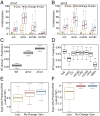Domains rearranged methyltransferase3 controls DNA methylation and regulates RNA polymerase V transcript abundance in Arabidopsis
- PMID: 25561521
- PMCID: PMC4311829
- DOI: 10.1073/pnas.1423603112
Domains rearranged methyltransferase3 controls DNA methylation and regulates RNA polymerase V transcript abundance in Arabidopsis
Abstract
DNA methylation is a mechanism of epigenetic gene regulation and genome defense conserved in many eukaryotic organisms. In Arabidopsis, the DNA methyltransferase domains rearranged methylase 2 (DRM2) controls RNA-directed DNA methylation in a pathway that also involves the plant-specific RNA Polymerase V (Pol V). Additionally, the Arabidopsis genome encodes an evolutionarily conserved but catalytically inactive DNA methyltransferase, DRM3. Here, we show that DRM3 has moderate effects on global DNA methylation and small RNA abundance and that DRM3 physically interacts with Pol V. In Arabidopsis drm3 mutants, we observe a lower level of Pol V-dependent noncoding RNA transcripts even though Pol V chromatin occupancy is increased at many sites in the genome. These findings suggest that DRM3 acts to promote Pol V transcriptional elongation or assist in the stabilization of Pol V transcripts. This work sheds further light on the mechanism by which long noncoding RNAs facilitate RNA-directed DNA methylation.
Keywords: DNA methylation; RNA polymerase; epigenetic regulation; gene silencing; non-coding RNA.
Conflict of interest statement
The authors declare no conflict of interest.
Figures






Similar articles
-
The cytological and molecular role of domains rearranged methyltransferase3 in RNA-dependent DNA methylation of Arabidopsis thaliana.BMC Res Notes. 2014 Oct 14;7:721. doi: 10.1186/1756-0500-7-721. BMC Res Notes. 2014. PMID: 25316414 Free PMC article.
-
The de novo cytosine methyltransferase DRM2 requires intact UBA domains and a catalytically mutated paralog DRM3 during RNA-directed DNA methylation in Arabidopsis thaliana.PLoS Genet. 2010 Oct 28;6(10):e1001182. doi: 10.1371/journal.pgen.1001182. PLoS Genet. 2010. PMID: 21060858 Free PMC article.
-
Polymerase IV occupancy at RNA-directed DNA methylation sites requires SHH1.Nature. 2013 Jun 20;498(7454):385-9. doi: 10.1038/nature12178. Epub 2013 May 1. Nature. 2013. PMID: 23636332 Free PMC article.
-
RNA-directed DNA methylation and Pol IVb in Arabidopsis.Cold Spring Harb Symp Quant Biol. 2006;71:449-59. doi: 10.1101/sqb.2006.71.028. Cold Spring Harb Symp Quant Biol. 2006. PMID: 17381327 Review.
-
Non-coding RNA transcription and RNA-directed DNA methylation in Arabidopsis.Mol Plant. 2014 Sep;7(9):1406-1414. doi: 10.1093/mp/ssu075. Epub 2014 Jun 25. Mol Plant. 2014. PMID: 24966349 Review.
Cited by
-
Unravelling Differential DNA Methylation Patterns in Genotype Dependent Manner under Salinity Stress Response in Chickpea.Int J Mol Sci. 2023 Jan 18;24(3):1863. doi: 10.3390/ijms24031863. Int J Mol Sci. 2023. PMID: 36768187 Free PMC article.
-
Expression Patterns of DNA Methylation and Demethylation Genes during Plant Development and in Response to Phytohormones.Int J Mol Sci. 2021 Sep 7;22(18):9681. doi: 10.3390/ijms22189681. Int J Mol Sci. 2021. PMID: 34575855 Free PMC article.
-
A conserved Pol II elongator SPT6L mediates Pol V transcription to regulate RNA-directed DNA methylation in Arabidopsis.Nat Commun. 2024 May 25;15(1):4460. doi: 10.1038/s41467-024-48940-8. Nat Commun. 2024. PMID: 38796517 Free PMC article.
-
Two Components of the RNA-Directed DNA Methylation Pathway Associate with MORC6 and Silence Loci Targeted by MORC6 in Arabidopsis.PLoS Genet. 2016 May 12;12(5):e1006026. doi: 10.1371/journal.pgen.1006026. eCollection 2016 May. PLoS Genet. 2016. PMID: 27171427 Free PMC article.
-
Genetic and environmental drivers of large-scale epigenetic variation in Thlaspi arvense.PLoS Genet. 2022 Oct 12;18(10):e1010452. doi: 10.1371/journal.pgen.1010452. eCollection 2022 Oct. PLoS Genet. 2022. PMID: 36223399 Free PMC article.
References
-
- Jones PA, Takai D. The role of DNA methylation in mammalian epigenetics. Science. 2001;293(5532):1068–1070. - PubMed
-
- Beard C, Li E, Jaenisch R. Loss of methylation activates Xist in somatic but not in embryonic cells. Genes Dev. 1995;9(19):2325–2334. - PubMed
-
- Fedoroff NV. Presidential address: Transposable elements, epigenetics, and genome evolution. Science. 2012;338(6108):758–767. - PubMed
-
- Chan SW, Henderson IR, Jacobsen SE. Gardening the genome: DNA methylation in Arabidopsis thaliana. Nat Rev Genet. 2005;6(5):351–360. - PubMed
-
- Martienssen RA, Colot V. DNA methylation and epigenetic inheritance in plants and filamentous fungi. Science. 2001;293(5532):1070–1074. - PubMed
Publication types
MeSH terms
Substances
Associated data
- Actions
Grants and funding
LinkOut - more resources
Full Text Sources
Other Literature Sources
Molecular Biology Databases

